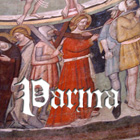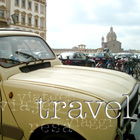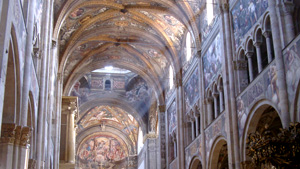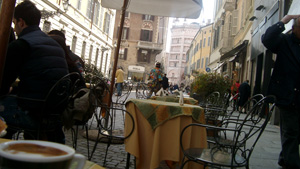
|
A HISTORY OF ANCIENT TRIBAL, IMPERIAL & RENAISSANCE FEUDS, RICH ARTISTIC TRADITION & A HIGH STANDARD OF LIVING Updated 2 June 2006 :: Lainey Johr Famed for its cured ham and zesty cheese, Parma is a gracious Italian city. Oozing with quaint, delightful shops, restaurants and historical sites, this savory mini-metropolis wraps you in a wonder of old-school charm. There is a little bit of everything here, whether your tastes are musical or historical, Parma is an ideal place for a short weekend or a perfect day trip from nearby Bologna. Easily accessible by train, grab a book, some walking shoes and a pair of (fashionable) sunglasses, and out you go—all that is needed to enjoy a perfect, hushed day of discovery. Another of Italy’s famed medieval cities, but not an isolated hilltop fortress, and surrounded by modern expansion, Parma’s center offers an array of delights for the pedestrian. Named by French newspaper Le Monde as the best city for living in Italy, the city caters to visitors and residents alike with equal care and attention to good living. Although the more recent and rather bland, block-walled city expansion makes for a stark contrast to its visually enticing city center, there is enough to do and to see to please even the most discriminating visitor. Nestled along the Torrente Parma (Parma Torrent, or river), the old city’s small size of about 2 square miles invites you to sit down, relax and feel at home after just an hour’s stroll.
Nicely punctuated with outdoor cafes, practically every point of interest in town can be followed by a short café break, or if you’re hankering for something a bit more savory, some antipasti and fresh pasta. Highly regarded for its cuisine, eating and drinking local treats is part of the culture, and surely part of any authentic Parma experience. The old city’s lure wades around the combined Piazza Pilotta and the Piazza della Pace. The flagship building on the simple, and surprisingly ample, grass-lawn park is the war-pocked Palazzo della Pilotta. Although the building’s façade leaves the architectural enthusiast in any of us in quizzical despair, it houses most of the city’s greatest works of art. In the complex you will find the Museo Archeologico Nazionale, the Teatro Farnese and the Galleria Nazionale, each with plenty to see. Begun in 1602 and bombed during in 1944, during the Second World War, it was named after a game, pelota, which was often played in the courtyard. Today, a summer air of sunbathing and picnics mingle with lovers strolling and mothers giving their children a taste of country life as they play across the dual piazzas’ flat, grassy fields. A rarity in Parma’s center, laced with cyclists, you needn’t fear a trampling or expect to hear the excited brrrring! of a bicycle bell, as even riders must dismount and walk here. One of Parma’s masterful expressions of renaissance art can be found in the Camera di San Paolo. It has been named the Camera di Correggio for his application of magnificent frescoes inside the apartment’s vault. Originally a convent, its owner, the humanistic Badessa Giovanna di Piacenza, commissioned Correggio and Alessandro Araldi to fresco the refectory and adjacent chamber in 1510. Corregio’s allegorical marvel is thought to depict the Badessa’s (Abbess’) interpretation of ‘the conquest of moral virtue.’ In the adjacent chamber is Araldi’s great work depicting ‘the conquest of spiritual virtue.’ Both of these ceiling frescoes, as well as the Badessa’s humanistic school of thought worried the papacy, who ordered the convent and its controversial works shielded from the world, seen only by the convent sisters and amazingly forgotten by the world until the 18th century. This order by the Counter-Reformation Church signaled a reign of oppression and suffocation of the region’s scholarly life. These works mark some of the greatest representations of the late Italian Renaissance. For a relatively small (albeit important) Italian city, it truly has a marvelous Duomo, or main Cathedral, dating back to 1178. Some say it is the most ambitiously frescoed of Italy’s great Cathedrals, and taking one step inside you can easily see why. The Old Testament, the Gospels and many Biblical scenes leave no inch of its great nave untouched. Correggio’s masterpiece, The Assumption, covers the entire dome. It is one of the first and best examples of illusionist frescoes. Strangely, this work, along with works of the other five principal artists, were poorly received by the people of Parma and caused Correggio to leave town in repugnance. The Duomo is truly astounding, as is the work inside the nearby Bapistry. An octagonal building in the courtyard of the Duomo, it is thought the Baptistry was used for baptisms and other ceremonies. Parma’s history dates back to its Roman roots in 183 BC. Remaining a constant, busy little city under the Romans, it continued to enjoy relative prosperity and quiet importance under the Byzantines and later Lombards and Franks. It was not until the 11th century that Parma’s control was taken by the papacy under local bishops. Soon an established comune, Parma’s grand Duomo, Baptistry and university were built. Power struggles continued into the 1100’s between the pope and the emperor, and Parma often saw itself in the middle of the rift. Via Francigena, still in use today, became a main road through the empire, bringing merchants and pilgrims to town. Emperor Frederick II’s attempts to control Northern Italy and run the Parmigiani out of town were stifled by the people, who captured his encampment and forced and end to the insurrection. Despite internal struggles among powerful families, a tailor named Barisello convinced the warring parties to lay low for fear of another external power seizure. This worked, and the people ruled their own fates under a nobleman for the people or capitano del popolo, Gilberto da Gente, until 1259. This was a period of great internal unrest, culminating in economic and social misery along with the great plague of 1347. This did not last long however, as local internal interests led to the city being ruled by various signori, eventually leading to a vicious civil war in 1466. A list of noble families shared dominion of the region, including the Visconti family. Although the following century was rife with wars and instability, some of the best known renaissance artists honed their crafts, such as Correggio and Parmigianino. Born in 1468, Alessandro Farnese was the region’s most influential nobleman. Taking advantage of internal struggle, he clutched power over Parma and the papacy, becoming Pope Paul II in 1534. A patron of the arts, including the famed Michelangelo, he managed to foster church reform whilst simultaneously weighing his family’s purse. Interestingly, he began as a cleric, owing much of his success to an income and influence gained through his sister, Giulia. Alessandro later was named the mistress to then Pope Alexander VI. In 1545 he bestowed the rule of Parma to his son, Pier Luigi. Pier’s rule ended abruptly. He was assassinated by local aristocrats who were under the tutelage of the King of Spain and Holy Roman Emperor, Charles V. Pier Lugi’s son, Ottavio, ruled the region for nearly forty years until 1586, and moved the capital to Parma. Partial to the King of Spain, he spent much time fighting abroad. It was during the rule of his ruthless successor, Ranuccio I, that the grand ducal Palazzo Pilotta, was built. His taste for the ornate and oppressive aristocracy was aimed not only at architectural constructions, but also at the people, as he demanded full control. This ended in the execution of over one hundred dissenters. The following heirs to power over Parma faced great external challenges. Among the challengers was Innocent X, who came from a rival family, the Lazio, is famous for painting a pair of pants on some nudes done by Michelangelo. Eventually, the Parmigiani signori power buckled under the weight of external pressures. Ranuccio’s successor, Francesco Maria sought the protection of the papacy when his Duchy of Parma became rather weak and fledgling compared to its more grandiose past. Several families held influence at this time, including the Pallavicino family and the Landi family, whose feudal claims to the greater Parma region can still be seen today. This was in no significant contrast to the entire Italian state of economic affairs, which by 1600 had become rather stifled. By 1682, the Farnese family had taken control of Parma from other rival families and helped to enhance the region’s privileged circumstance. The prosperity of the region was rather rare at this time when compared to surrounding regions. In particular, Parma’s strong agricultural and famous dairy sector held it in reasonable economic standing through continued exports and demand. During this period, there were an astounding 49 hospitals in the Parma region. After the Wars of Spanish Succession, the Farnese family became powerless. Dominion over Parma was granted to Charles of Bourbon, the son of Philip V of Spain and Elisabeth Farnese, in 1731. He crated Parma’s artistic treasures along with the city’s entire library down to Naples, where he became Charles III of Naples and ruled Parma from there for the next 14 years. Thankfully for Parma, the city regained many of its historic artifacts in the 1920’s. The city’s characteristic flair for the French came from the next successor to the Duchy, Charles’ brother, Filippo. In an effort to repopulate the city and its palace with regality, he set his wife to France to acquire a new set of ornaments and to create a new feeling of grandeur. As the daughter of France’s Louis XV, this was no difficult task for her. She brought with her many skilled Frenchmen along with bundles of new baubles—so much so that French people soon became one eighth of the total Parma population! Many of them were great writers, cooks, artists and architects. These expatriated Franco-Italians enjoyed great artistic and cultural freedom in the Duchy of Parma, particularly under the Duke’s minister, M. Guillaume du Tillot. He exiled the Jesuits, and changed the color of Parma, slashing the importance and privilege of nobility, taking their great wealth and encouraging greater freedom to the underclass. Soon, Parma became an Italian hub of enlightenment, with a very French twist. Times changed quickly enough, however, under the Duke’s son and heir, Ferdinando in 1765. Weak and gutless, he was dominated by his pious and shrill wife, Maria Amalia. Described as an ugly and unremarkable character, Maria Amalia’s devotion to little but the maligning of du Tillot ended in the demand of her husband to denounce him. In the wake of du Tillot’s retreat from power, most of the French intellectuals went back to France, and the new reforms and institutions were handily reversed by the return of the Jesuits. The French did come back however, this time they were not the exiled intellectuals, but Napoleon in 1796. While the Duchy of Parma was allied with Spain, all went smoothly for the city-folk. Although Parma later allied with Tuscany, and Napoleon levied heavy war taxes on the region, he did install a new governor, Moreau de Saint-Mery. Like du Tillot, he favored culture and intellectualism, bringing a breath of fresh air back to Parma’s enlightened population. This spirit continued despite the fall of Napoleon in 1814, and the imposition of a new governor, Francesco Magawly-Cerati. Napoleon’s second wife, Marie-Louise of Austria was granted Parma at the Congress of Vienna. She was rather good looking and the people of Parma welcomed her with open arms. External forces once again dominated the path of the Parmigiani when Austrian influences forced Marie-Louis to make some rather unpopular mandates. In light of these unsavory policies, the secret nationalistic society called the Carbonari was formed and staged rebellions against Austrian influence in Parma and the region. After an Austrian troop crushed a Carbonari revolt, the people remained silent but bitter with the defeat. Marie-Louise’s death in 1847 brought the Bourbons back in power. Bourbon Duke Carlo II was so unpopular he was ousted in no less than one year, and his son, Carlo III, ruled Parma in his stead. Death by stabbing was his demise in 1854 and his young son, Duke Roberto I, tried ruling through the guidance of his mother- but to little avail. Their legitimacy lasted a mere five years until both a local revolt and the Piedmontese-Austrian War ended the Duchy for good. Soon after, in 1860, Parma became an official part of the modern state of Italy. Parma’s new home as a regional capital under the new Italian state humbled its once splendid civilian and economic life. New roads and railways were an attempt to encourage Parma out of a depression. The second half of the century and continued unrest spurred the Trades Union Organization. Subsequent striking from the working class through the early years of the twentieth century came to a head in 1922, launching the first wave of anti-Fascist rebellion, known as el barricate. After years of war and destruction left Parma crippled, it was not until the region’s liberation in 1945 that the region saw peace. |
||||||||||||||||||||||||||
|
|||||||||||||||||||||||||||












